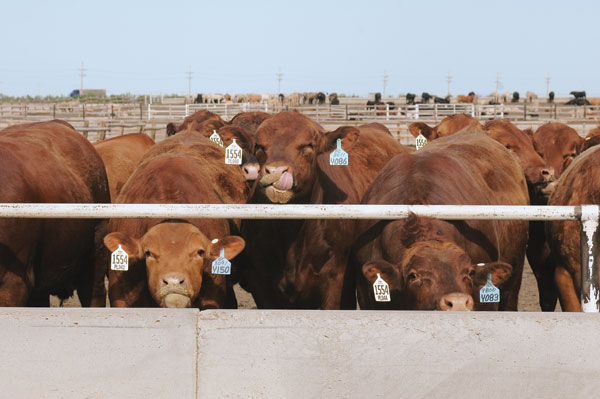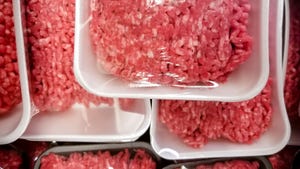Feeding Cattle Is All About Feeding The Microbes
The science of feeding cattle basically boils down to feeding the microbes in their rumen.
August 29, 2012

When you talk about feeding ruminant animals, what you’re really doing is feeding the microbes in the rumen. And when you think about nutrient requirements for cattle, you first need to ensure that the nutrient requirements of the microbes are met so that they can do their job.
That’s how Janice Bowman, Montana State University professor of animal and range sciences, explains the science of feeding cattle.
Bowman says there are numerous species and types of bacteria, protozoa and fungi present in the rumen, all with different characteristics. The presence of these various microbes and their affinities for different feed ingredients is a key reason why ruminants can successfully live on both high-roughage and high-concentrate diets.
Each microbial species is specialized in what it consumes and produces, and how it will interact with other microbial species during digestion. A diverse and well-balanced diet will result in a more diverse microbial population and, consequently, a more efficient rumen.
“The rumen is really a fermentation vat that is constantly churning its contents; larger particles are retained in the rumen for more digestion, while smaller particles are flushed out. Tiny finger-like projections, called papilla, on the rumen wall increase the surface area and, thus, the absorptive capacity of the rumen itself,” explains Jeff Carter, ADM Alliance Nutrition beef nutritionist, about rumen anatomy and function.
To help ensure a healthy rumen environment, Dan Wolf, ADM Alliance Nutrition sales representative, suggests feedlot managers implement a strategic deworming program, maintain adequate fiber in the diet and provide a balanced mineral appropriate for the overall diet.
Bowman notes that during the digestion process, microbes are responsible for producing volatile fatty acids, which are the source for 70%-80% of the animal’s energy. Finding ways to maximize efficiency and digestion of individual rumen microbes results in better animal performance.
Bunk management
“Consistency is a big key in ruminant digestibility and health,” Wolf says. To ensure that everything is performing optimally in the rumen, he looks for visible signs.
“I’m a big believer in walking the bunk line, and looking in the bunks to determine what cattle are eating. You can see if those calves are sorting their feed. You can also tell a lot by looking at the consistency and color of manure.
“If all the cattle in the pen are rushing the bunk when the farmer starts the tractor, they’re definitely too hungry. I like to see about a quarter of the pen standing at the bunk, with the balance slowly making their way to the bunks as they’re fed,” Wolf says.
 Ration ingredient selection and degree of processing are other areas of consideration when working to maximize ruminant digestion. Tim McAllister, a principal researcher at Lethbridge Research Centre in Alberta, Canada, says understanding the impact of various levels of processing for different grain crops, and the economic impacts related to grain processing, are critical when striving to maximize performance and return.
Ration ingredient selection and degree of processing are other areas of consideration when working to maximize ruminant digestion. Tim McAllister, a principal researcher at Lethbridge Research Centre in Alberta, Canada, says understanding the impact of various levels of processing for different grain crops, and the economic impacts related to grain processing, are critical when striving to maximize performance and return.
“We have to consider surface area related to particle size. A smaller particle has a larger surface area, which more microbes can attack and more rapidly digest. This can lead to the production of too much acid in too short a time, and possibly acidosis. But, if the hull isn’t cracked or broken, and we’re essentially feeding whole grains, their shells are very resistant to microbial digestion, and we end up with more grain going out in the feces, which we also want to avoid,” he explains.
Much of McAllister’s research focuses on the ability of rumen microbes to digest various grains at different degrees of processing. He says wheat and barley are much more rapidly fermented in the rumen compared to corn and sorghum. But if you process corn to a fine particle size, it will surpass moderately processed barley in the time it takes to be fermented.
“You need to process grains to some degree to maximize utilization and, with the price of grain crops today, it pays to process them for the increased digestibility. What will work best in a particular situation depends heavily on availability and price of a given grain crop,” he adds.
Relatively new feedstuffs are also a viable option for increasing rumen efficiency. Wolf says when used correctly in rations, distillers grains can help enhance feed efficiency.
Range considerations
In a range situation, Bowman says microbes that digest cellulose have the competitive advantage, and adding energy supplements encourages the reproduction of microbes that digest starches.
“Microbes that prefer starch have a faster growth rate. They can reproduce and increase their numbers very quickly, and they can also break down starch very quickly, producing volatile fatty acids, or energy, at a much faster rate,” she says.
If starch is added to the diet rapidly, specific microbes will convert it to volatile fatty acids so quickly that the pH in the rumen will drop, she explains. Since the cellulose-digesting microbes don’t like a low pH, they won’t prosper as well in that situation, and the depression of cellulolytic digesting microbes can result in reduced fiber digestion. That will cause feedstuffs to move slower through the digestive tract, and result in reduced intake by the animal.
“You want to create a situation where you balance the diet, and the microbe populations, to garner the best utilization of everything that cow is consuming,” Bowman says.
McAllister suggests a supplement high in fiber to aid in digesting low-quality winter forages; it will also complement any nutrients not present at adequate levels in the forage.
Bowman lists protein, or nitrogen, as another key ingredient for rumen microbe health and growth in any situation. Microbes themselves are a key source of protein to the animal, and ensuring adequate protein is available to rumen microbes will benefit digestion and performance in any environment.
“We need to remember that what we’re feeding first in a ruminant are the microbes, because they have first access to producing usable energy from a feedstuff. If we make sure we’re meeting their needs so they can do their job, the entire animal will benefit,” Bowman concludes.
Heather Hamilton is a rancher and freelance writer based in Lance Creek, WY.
You May Also Like



